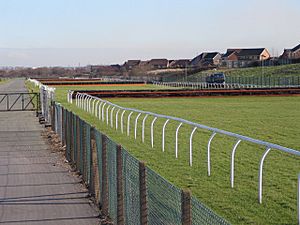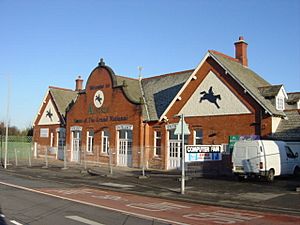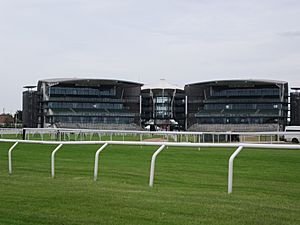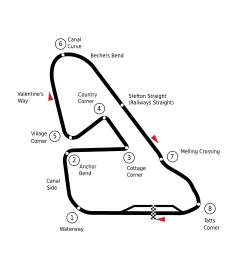Aintree Racecourse facts for kids
 |
|

The racecourse in 2006
|
|
| Location | Aintree, Merseyside, England |
|---|---|
| Owned by | Jockey Club Racecourses |
| Date opened | 7 July 1829 |
| Screened on | Racing TV |
| Course type | National Hunt |
| Notable races | Grand National |
Aintree Racecourse is a famous place for horse racing in Aintree, Merseyside, England. It's close to the big city of Liverpool. Every April, Aintree hosts the exciting Grand National horse race. This big event lasts for three days. Aintree also has other race days in May, October, November, and December.
The Aintree Racecourse has faced some big challenges. The 1993 Grand National had no winner because of many false starts. The 1997 Grand National was moved to a different day because of a bomb threat. More recently, the 2023 Grand National was delayed by animal rights protesters.
Contents
Aintree Racecourse: A Look Back
Horse racing was popular in Liverpool a long time ago, even during the Tudor period. In the 1700s, a man named Nicholas Blundell organized races on the sandy beaches at Crosby.
How Aintree Racecourse Started
In 1829, William Lynn, who owned a hotel in Liverpool, wanted to create a new racecourse. He talked to the Second Earl of Sefton, William Philip Molyneux, who was also known as 'Lord Dashalong'. Lord Sefton loved racing, so he agreed to let Lynn use his land.
The first stone for the racecourse was laid on February 7, 1829. Lynn quickly built a grandstand, and the first race meeting happened on July 7, 1829. The first race was won by a horse named Mufti.
The First Steeplechase Races
In 1835, Lynn started organizing hurdle races, which were very popular. A famous rider, Captain Martin Becher, even took part and won two races. Captain Becher told Lynn about a long cross-country race called the Great St. Albans Steeplechase. This made Lynn want to create a similar race at Aintree.
With Captain Becher's help, Lynn organized the Liverpool Grand Steeplechase. The first race was on February 29, 1836. Ten horses competed, ridden by gentlemen. Captain Becher, who later had a famous fence named after him (Becher's Brook), rode The Duke to victory. Some people think this 1836 race was the first Grand National. However, most historians believe the 1839 race was the true beginning.
The Grand National Begins
By 1839, important people like Lords Derby and Sefton became interested in a national racing event at Aintree. The race was called the 'Grand Liverpool Steeplechase'. It was advertised as "four miles across country," but it started and finished on the racecourse.
The course had 29 obstacles, including a five-foot-high stone wall. One famous obstacle was a "strong paling, next a rough, high jagged hedge, and lastly a brook about six feet wide." During the race, Captain Becher fell into this brook. He famously said, "water is no damned use without brandy!" A horse named Lottery won the race. About 50,000 people came to watch this first 'National' race.
Aintree's Growth and Changes
The race quickly became very popular. William Lynn's health declined, and Edward William Topham took over. In 1843, Topham changed the 'National' into a handicap race, meaning horses carried different weights based on their ability. The race officially became the 'Grand National' in 1847.
The Grand National and Aintree Racecourse grew in popularity throughout the late 1800s. It became the most important race in the national hunt calendar.
Aintree During the Wars
The Grand National was held in 1914, just before the First World War began. The 1915 race also took place at Aintree. However, in 1916, Aintree was used by the army, so a different race was held at Gatwick instead. The Grand National returned to Aintree in 1919.
During the Second World War, one race was held at Aintree in 1940. After that, the course was used as a storage place for soldiers from the USA. Aintree reopened for racing on April 4, 1946. The Grand National was run on a Friday that year, but it moved to a Saturday in 1947.
New Owners and Improvements
In 1949, the Topham family bought the racecourse completely. To celebrate, they introduced the Topham Trophy race. In 1953, the Mildmay steeplechase course opened. It had smaller versions of the Grand National fences. This allowed Aintree to host only jump races for the first time.
In the 1960s and 1970s, there was worry that Aintree might be sold for housing. In 1973, the Topham family sold the racecourse to Bill Davies. Attendance at the Grand National dropped in 1975 because Davies tripled ticket prices. However, the race meeting improved in 1976 under new management.
The future of Aintree became secure in December 1983 when the Jockey Club bought the course.
Modern Aintree
Most of Aintree's old stands were taken down in 1985. New stands were built over the years. The Queen Mother opened a new permanent stand in 1991, named after her.
In 1995, Red Rum, the only horse to win the Grand National three times, passed away. He was buried near the winning post. A statue of him was put up at the course in 1988.
In 1998, a new stand named after the Princess Royal was opened. More big changes happened in 2006, with a new parade ring and winners' enclosure. In 2007, two more grandstands were opened, named after the Earl of Derby and Lord Sefton. In 2015, the old weighing room was named 'McCoys' to honor the jockey A. P. McCoy.
Aintree's Race Courses
Aintree has three main courses for horse racing: the Grand National course, the Mildmay steeplechase course, and the Hurdles' course.
The Grand National Course
The Grand National course is shaped like a triangle and is about 2 miles 2 furlongs long. It has 16 fences, including three open ditches and a water jump. The fences are between 4 feet 6 inches and 5 feet 2 inches tall. 'The Chair' is the largest fence.
Some fences, like Becher's Brook, have a drop on the landing side. This means the ground is lower after the jump. The drop at Becher's has been made smaller in recent years. This course is known as one of the toughest in the world. Its fences include famous ones like the Chair, Foinavon, Valentine's, Canal Turn, and Becher's Brook. All the fences, except the water jump, are covered with spruce branches.
Four other races also use the Grand National fences. These are the Topham Trophy Chase, the Fox Hunters' Chase, the Grand Sefton Handicap Chase, and the Becher Chase. Over the years, the fences have been changed to make them safer for the horses and riders.
The Mildmay Course
The Mildmay Course is named after Lord Anthony Mildmay, a famous amateur jockey. He thought Aintree needed a "nursery" course with smaller versions of the Grand National fences. This would help new horses get used to Aintree's unique jumps.
The Mildmay course opened in December 1953. It allowed Aintree to host only jump races for the first time. The course is an oval shape, a little over 1 mile 2 furlongs long, with eight fences. It was not very popular with trainers at first. In 1975, the spruce fences were replaced with standard birch fences. The course was changed again in 1990 to improve it.
The Hurdles' Course
The Hurdles' Course is the oldest of Aintree's three courses. It used to be the flat course. It's a left-handed oval, about 1 mile 3 furlongs long, with sharp turns. It has six hurdle jumps.
The last flat race at Aintree was in 1976. On this course, on April 7, 1967, a two-year-old horse named Red Rum raced for the first time at Aintree. He tied for first place in a five-furlong race. Red Rum later became the most famous Grand National winner.
The Grand National Race
The Grand National is a very long and challenging horse race. It used to be 4 miles 856 yards long. In 2013, the start line was moved to keep the horses away from the crowd's noise. The race is now about 4 miles 514 yards (7.2 kilometers) long. It's known as one of the toughest steeplechases in the world.
The lead in the race often changes in the final stretch after the last fence. Usually, 40 horses take part in the race. However, often fewer than ten horses finish the course. For example, in 1928, 42 horses started, but only two finished! The horse with the most Grand National wins is Red Rum, who won three times in the 1970s and came second twice.
Grand National Race Delays
Aintree Racecourse has seen several delays to the Grand National. The 1993 Grand National was not held because of many false starts at the beginning of the race. The 1997 Grand National was moved to a Monday because of a bomb threat, which led to 60,000 people being evacuated. In 2023, the race was delayed by Animal Rising protesters.
Other Events at Aintree
Aintree is not just for horse racing! It has also hosted other exciting events.
Motor Racing at Aintree
Aintree has a history with motor racing. The British Grand Prix was held there five times: in 1955, 1957, 1959, 1961, and 1962. The circuit also hosted other Formula 1 races that were not part of the championship. The last winner of these races was Jack Brabham in 1964.
One unique person who competed in both horse and motor races at Aintree was Alfonso de Portago. He rode in the Grand National in 1950 and 1952. He also drove a Ferrari race car at Aintree in 1955. Sadly, he passed away in May 1957 before he could race at the 1957 British Grand Prix at Aintree.
Music Concerts at Aintree
Aintree has been a venue for big music concerts.
- Michael Jackson finished the European part of his 1987–1989 Bad World Tour at Aintree on September 11, 1988. More than 125,000 people attended. He also planned to perform there in 1992, but those plans were cancelled.
- P!nk performed at Aintree during her I'm Not Dead Tour on July 16, 2007.
- Kaiser Chiefs and the Chemical Brothers also performed concerts at Aintree in 2007.
Golf at Aintree
The racecourse also has a 9-hole golf course and a driving range. Some famous parts of the racecourse, like Becher's Brook, are part of the golf course. The golf facilities are closed when horse or motor races are happening.
How to Get to Aintree
Aintree Racecourse used to have two train stations. One station, Aintree Racecourse, closed in 1962. The other, Aintree Sefton Arms, opened in 1849 and is still open today, now simply called Aintree.





